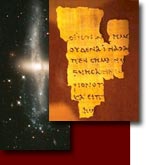| Site Map | Contacts | Links | Newsletter | |
The Bible:
Revelation
One of the key verses in understanding the book of Revelation is chapter 17:9-11 which says, "The 7 heads are 7 hills on which the woman sits. They are also seven kings. 5 have fallen, 1 is, the other has not yet come" (NIV). This seems to refers to the Roman empire and seems to best fit the kings as follows:
- Julius Caesar (49-44 BC.)
- Augustus C.(31 BC-14 AD
- Tiberius C. (14-37 AD.)
- Caligula C. (37-41 AD)
- Claudius C. (41-54 AD)
- Nero Caesar (54-68 AD)
The 5 fallen kings means Nero is emperor (Gentry 1989b, 104). This is how Josephus counted the emperors in Antiquities of the Jews (Book 19.1.11). Others count Vespasian or Titus as the last king.
Persecution
Nero was the first to persecute the Christians. He blamed the burning of Rome on the Christians in 64 AD. Nero used the Christians as human torches to light his garden. This means that the Great Tribulation of 7 years had already begun. This persecution was the war with the beast, Nero.
Historian Schaff states, "There is scarcely another period in history so full of vice, corruption, and disaster as the six years between the Neronian persecution and the destruction of Jerusalem" (1910, 1:391; Gentry, 1989b,127).
The Mark of the Beast - 666
In ancient times letters were used as numbers. For example A=1, B=2, C-3 and so forth. So names had a certain numerical value. The Hebrew spelling of Nero Caesar (Neron Kaiser) adds up to exactly 666. There is a textual variant in Revelation 13:18 with the number 616 which is probably the Latin equivalent of Nero Caesar.
Worship of the Beast
Emperor cult worship is well known in the Roman empire. Nero claimed to be the equal of the god Apollo. Seneca taught Nero that he was destined to become the revelation of divine Augustus and the god Apollo(Seneca On Clemency 1.1.6; Gentry 1989b, 63).
Revival of the Beast
Revelation 13:10 relates to Nero’s death. Nero who killed with the sword would die by a sword that he put in his own throat June 9, 68 AD (Suetonius Nero 49; Gentry, 1989b, 63). The death of Nero meant the end of the Julio-Claudian line of emperors. Civil wars broke out. Vespasian revived the empire and saved it from ruin. There were also rumors that Nero was still alive and would return to power.
The Temple
In the Book of Revelation the Temple is still standing which indicates that this happened before 70 AD when the city and temple of Jerusalem was destroyed by Titus.
Fall of Babylon
The fall of Babylon in chapter 18 of Revelation seems to refer to the fall of Jerusalem. The Jews have rejected Christ. Therefore they have become apostate and have committed spiritual adultery with Rome. Another popular view sees Babylon as referring to Rome.
Coming of Christ
Christ’s coming was in Judgment like the Day of the Lord in the Old Testament. The judgment was the destruction of Jerusalem and the Temple by the hands of Titus. Christ is ruling and reigning now. There is no need for a temple for he is the temple.
Sealing the Saints - 144,000
In Revelation chapter 7 144,000 Christian Jews in Israel are sealed so they will be safe. In Matthew 24:16 they were commanded to flee to the mountains for safety which was the transjordan mountains where Pella was located. Eusebius tells how the Jews in Jerusalem were commanded by revelation to escape to Pella (Eusebius Ecclesiastical History, 3.5.3) There is also a great multitude of Christians from every nation. Clearly Christians went through this tribulation.
Parallel Passages
Matthew 24 and Luke 21 are parallel passages to Revelation. Clearly they point to the fulfillment of scripture in 70 AD with the destruction of Jerusalem which is the abomination of Desolation. This refers back to the book of Daniel chapter 9:27.
The Two Witnesses
The two witnesses in Revelation 11 who are killed are probably Jesus who rises again and Stephen who was stoned. The early church believed they were Enoch and Elijah or Jeremiah.
100 lb. Hailstones
Revelation 16:21 tells how huge hailstones fell from heaven weighing a talent which is about 100 pounds. Josephus describes 100 lb. white stones coming from Roman catapults down on the Jews in Jerusalem (Jewish Wars, Book 5.6.3).
Letters to 7 Churches
The letters to the seven churches indicate a time period that best fits the time in the decade of the 60’s AD (Gentry 1989b, 175-80).
I Come Quickly
Revelation is written in the context that everything is going to happen soon (Rev. 1:19). Christ is coming back soon (Rev. 22:7,12,20), even in their generation.
This Generation
This generation that had pierced Christ would not pass away until all was fulfilled (Matthew 24:34) which culminated in the fall of Jerusalem.
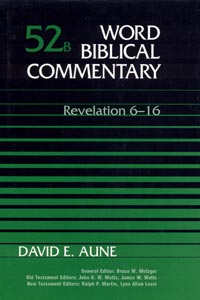 |
For an excellent detailed commentary on the Book of Revelation see Revelation: Word Biblical Commentary Volumes 52A,B,C by David Aune and published in 1997-98. |
Date of the Book of Revelation
According to Aune’s new commentary, Revelation was probably written and edited in several stages. The earliest part was probably written before the fall of Jerusalem and then edited in the reign of Domitian or later (Vol. 52A lvii-iii). To me the description of the Great Tribulation of Revelation best fits the three and a half years before the fall of Jerusalem. Josephus describes some of these terrible conditions. I highly recommend David Aune’s three volume in depth commentary on the Book of Revelation which is part of the Word Biblical Commentary series.
Astral Prophecy
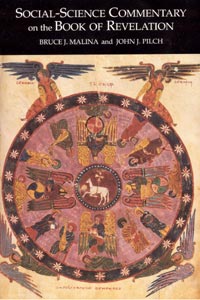 |
Social-Science Commentary on the Book of Revelation by Bruce Malina and John Pilch published by Fortress Press, 2000. |
There is a very interesting new book entitled Social-Science Commentary on the Book of Revelation by Bruce J. Malina and John J. Pilch and published by Fortress Press, 2000. They posit that the Book of Revelation in the Bible is an astral prophecy. The visions are seen as interpretations of the constellations in the sky. The first 11 chapters were probably written before the fall of Jerusalem of 70 AD.
Christ holds Seven Stars
In the first chapter of Revelation (1:16) Christ is described as holding seven stars in his right hand and a sword (comet shaped like a sword) proceeds out of his mouth. Josephus states, "There was a star resembling a sword, which stood over the city (Jerusalem), and a comet, that continued a whole year" (Wars of the Jews, Book VI, Chapter V.3). Josephus could be referring to Halley's comet that appeared in 66 AD which looked like it was coming out the mouth of the constellation Orion, Hercules, or Bootes from Jerusalem. A comet was an ominous sign warning of danger in the ancient world. This might have marked the beginning the Tribulation period. The seven stars might be the constellation Corona Borealis that has seven stars. The seven candlesticks are most likely the seven wandering stars in ancient times (5 visible planets plus the sun and moon). Stars were seen as angels, divine souls (Philo of Alexandria On the Giants ii, 6-8). As Christ’s constellation rises out of the South (Where Hades was), it symbolizes Christ’s resurrection from the dead. Thunder was seen as the voice of God.The Throne of God
In Revelation chapter four the throne of God is described. The throne of God is probably best seen as the constellation Cassiopeia that was a throne. The glassy sea probably refers to the Milky Way. The four living creatures would be the four constellation in the four corners of the heaven that signal the four seasons, Leo the Lion, Taurus the bull, Scorpio with a human face, and Pegasus the flying eagle in ancient times. The twenty-four elders are the 24 hours or decans that the sky was divided into during the course of a day in ancient astronomy. See the famous Hellenistic Dendera Zodiac.
The Lamb of God
In Revelation chapter five the constellation Aries (male lamb) is probably seen as the Lamb of God. The altar is probably the constellation right below Aries. Aries was identified with Israel and Syria in ancient times (Ptolemy, Tetrabiblos).Horses, Trumpets, and Bowls
Maline and Pilch think that the horses, trumpets, and bowls in Revelation refer to comets that look like these objects (p. 103-106; Tetrabiblos II, 90-91 LCL). There are six notable comets during the reign of Nero. In the last column the higher the number the more important the comet (0-10). The information is from Chronology of Eclipses and Comets AD 1-1000 by D. Justin Schove, 1984 (p. 287).
| Year AD | Month | Comet's Name | Importance |
|---|---|---|---|
| 55/56 | Dec/Mar | 1st Neronian | 5 |
| 60 | Aug | 2nd Neronian | 4 |
| 61 | Sept/Nov | 3rd Neronian? | 2 |
| 64 | May/July | 4th Neronian | 2 |
| 65 | July/Sept | Pre-Halley's | 5 |
| 66 | Jan/April | Halley's Comet | 7 |
The Four Horsemen
The four horsemen are from the four corners of the heavens. Each corner has its own cosmic color. This points to a certain planet in the constellations at the four corners of the cosmos. The Constellation Taurus is identified with the South, the color red, and the planet Mars. Scorpioman is identified with the North, black, and Mercury. Leo is identified with the East, white, and Jupiter (Green/blue). Thunderbird (Pegasus) is identified with the West, pale, Venus (white; Malina and Pilch, 2000, p.111).
The 5th Seal-Altar
When the 5th seal is opened, John sees an altar with souls under it that were martyred for the word of God (Rev. 6:9). I suggest that the altar be identified with the great square of Pegasus, and the souls should be seen as the stars in the Milky Way.
The Bottomless Pit
In Revelation 9 the 5th angel sounded and a star fell from heaven with the key to the bottomless pit. He opens the pit and smoke ascends with locusts coming out of the smoke that can sting like a scorpion for 5 months. I suggest that the star is the planet Venus that descends in the sky. Venus was thought to descend into Hades in ancient times. The Bottomless Pit is probably the South pole axis of the sky where there are no stars, and the Milky Way looks like smoke ascending from this pit. The constellations Scorpio and Sagittarius seem to guard the pit, the entrance way to Hades where the smoke ascends up forever. The 5 months are the time that the constellations Scorpio and Sagittarius can be seen in the sky at night. The locusts look like the ancient description of the centaur constellation Sagittarius.
In ancient times the Milky Way was identified with the river Styx. Souls would make their way from Hades up the Milky Way to Heaven (p.190).
Book of Revelation Monsters
In the Book of Revelation there are several monsters or dragons described. The Greek New Testament uses drakon 12 times only in the book of Revelation which the KJV translates as "dragon" (Rev. 12-13, 16:13, 20:2).
There is a red dragon in Revelation 12:1-18. Boll believes that the dragon corresponds best with the constellation Hydra which extends through one third of the zodiac. Just above the Hydra are the constellations Corax with 7 stars corresponding to 7 heads, and Crater with 10 stars corresponding to 10 horns, or 10 dorsal fins. Another possibility is the ancient constellation of scorpio (Malina and Pilch, 2000 p.165).
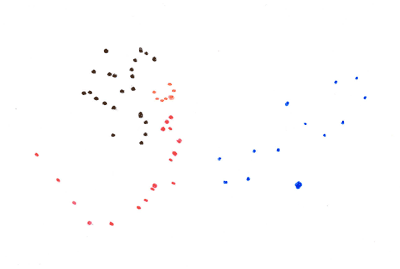 |
| Constellations: Serpens in red, Corona in orange, Virgo in blue, and Hercules in black. |
On today's star charts I think the dragon (which means serpent) should be identified with the constellation Serpens (Caput and Cauda connected with ten stars). The seven heads would be the constellation Corona (crown) Borealis which consists of 7 stars. This serpent is right at the feet of the constellation Virgo and Hercules. The Archangel Michael would be the constellation Hercules waiting to make war with the serpent (Rev. 12:7).
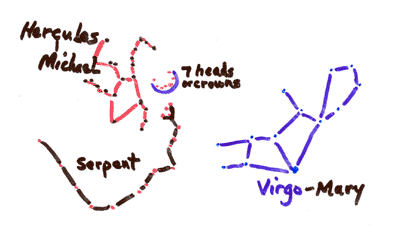 |
| Constellations outlined: Serpens in black with red stars, Corona in purple with orange stars,Virgo in purple with blue stars, and Hercules in red with black stars. |
The woman of Revelation 12 should be identified with the constellation Virgo. The woman is Mary who gives birth to Jesus. The 12 stars represents the 12 tribes of Israel. The 13 stars of the constellation Virgo may represent the 12 tribes plus Christ (the bright star Spica?). Another possibility is that the constellation Bootes represents the baby Jesus, and Mary's crown is the Big Dipper plus Canes Venatici.
The red dragon in Revelation 12 has seven heads similar to the leviathan in Ugaritic and Psalm 74:14 (Gibson, 50, 68; Walace, 290), and the Set-Typhon, red crocodile, of Egypt (NIV note 12:3).
Marriage of the Lamb (Rev.19)
When there was a conjunction of planets, it was seen as a marriage in the ancient world. There was a conjunction of Venus and Jupiter in 67 AD in the constellation Ares (the male lamb). There was a similar conjunction 70 years earlier in 2 BC which some think was the Star of Bethlehem.
Christ's Coming in Judgment (Rev.19)
Christ comes and fights the armies of the earth (Rev.19:19). The beast and false prophet and thrown into the lake of fire. There seems to be a great battle in heaven in May 70 AD. The planets Mars, Mercury, Venus and the sun seem to gather together for battle in the constellation Ares. Mars may represent the Beast while Mercury would be the false prophet. Venus (White) would represent Christ riding on a white horse coming to battle the beast. By next month the planets Mars and Mercury disappear from the sky as if cast into the lake of fire (the fiery sunset), but Venus rises to be the bright and morning star (Rev. 22:16).
Written by
Dr. Stephen C. Meyers
Bibliography
Aune, David. 1997. Word Biblical Commentary: Revelation 1-5. Dallas:
Word Books.
_____. 1998. Word Biblical Commentary: Revelation 6-16. Dallas: Word
Books.
_____. 1998. Word Biblical Commentary: Revelation 17-22. Dallas:
Word Books.
Gentry, Kenneth L.1989a. Before Jerusalem Fell. Tyler:Institute for
Christian Economics.
. 1989b. The Beast of Revelation. Tyler: Institute for Christian
Economics.
Eusebius.1955. Ecclesiastical History. Grand Rapids: Baker Book House.
Schaff, Philip.1910. History of the Christian Church. 7 Vols. Grand
Rapids: Eerdmans.
Seneca. On Clemency.
Suetonius. The Twelve Caesars. New York: Penguin Books.
Whiston, William. The life and Works of Flavius Josephus. Philadelphia:Universal
Book.
